
by Lidia Paulinska | Jan 17, 2016
January, 2016, Storage Visions – Mark Schiller is Executive Director of Trusted Computing Group, which provides security standards to the computing industry. The group is a collection of over 100 partners that include commercial companies, government participation, academia and experts in the field of security and privacy. Schiller covered the challenges facing security and protection of stored content, and shared his view on SEDs (Self Encrypting Drives).
Why Self-Encrypting Drives?
There are world-wide financial and legal consequences for data loss and data breeches and the occurrence of such events have been increasing. SEDs create a layer of protection from that happening as well as providing compliance with the safe harbor laws in the most of the US and EU for loss of devices that are secured with encrypted data. Schiller spoke after Michael Willett underlined the main reason of using SEDs. The SEDs have a lower overhead for encryption and decryption than software encryption. Another feature is SEDs allow for a fast crypto-erase that sanitizes drive data before drive replacement, repair, de-commissioning, re-purposing and end of life.
He summarized the talk with SSDs are the new standard for fast storage media. In combination with the NVMe storage interface, they are driving higher performance and lower latency solutions, meaning data safety can be realized without the negative impact of software encryption on system performance.
More information about Trusted Computing Group at www.drivetrust.com
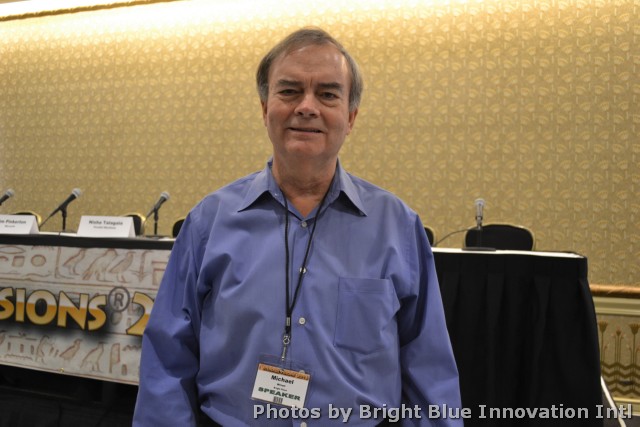
by Lidia Paulinska | Jan 17, 2016
January, Storage Visions – Michael Willett from Bright Plaza moderated the Storage Vision’s panel discussion about security and protection. He stated that the idea of encryption being built into the hardware is becoming universal. There are many benefits leaning on the concept of Hardware-based Self-Encryption being a better option over Software-based Encryption. First is the transparency and easy management. SEDs (Self Encrypting Drives) come from the factory with an encryption key already generated so there is no encrypting key to manage. Second, the Life-cycle cost. In the software case, it is an on-going cost versus pro-rated into the initial drive for SED. Third is disposal or re-purposing cost for the drive. It is easy to erase the on-board encryption key for SEDs providing safe disposal. There is also no problem with re-encryption as there is no need to ever re-encrypt the data. The last benefits are in (A) performance: there is no degradation in SED performance; (B) standardization: the entire HDD industry is building to the TCG/SED specifications, and finally (C) there is no interference with upstream processes or use.
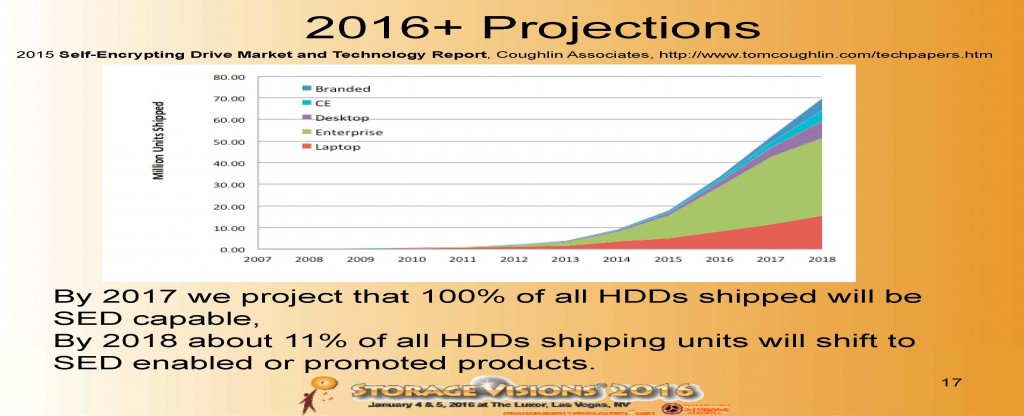
The session covered the challenges facing security and protection of stored content, including content on mobile devices as well as at home and in the cloud. It explored the reasons why OPAL based client encrypted storage is a key factor in data security, Standardized security products are making data security easier than ever while enabling desired content sharing.
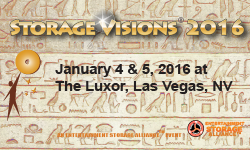
by Lidia Paulinska | Jan 17, 2016
Content matters more and more as there are more tools for people to capture it, make it useful and share with others – stated Tom Coughlin at Storage Visions Conference 2016 that took place January 4-5 at Luxor Hotel in Las Vegas. Two days conference was offering the insights into the storage industry.
As the highlights of the passing year Coughlin mentioned lots of mergers and acquisitions that took place: as such Dell buying EMC, WD buying SanDisk, NetApp buying SolidFire. 2015 was a year of emergence of NVMe specification and work on NVMe optimization programming. Samsung introduced 3rd generation 3D NAND SSDs as well as all the other FLASH companies. Intel/Micron announced 3D Xpoint.
What to expect in 2016 and beyond? Definitely Panoramic Video and VR along with IoT will drive content growth in the next years. Here are the numbers that were presented to support this statement.
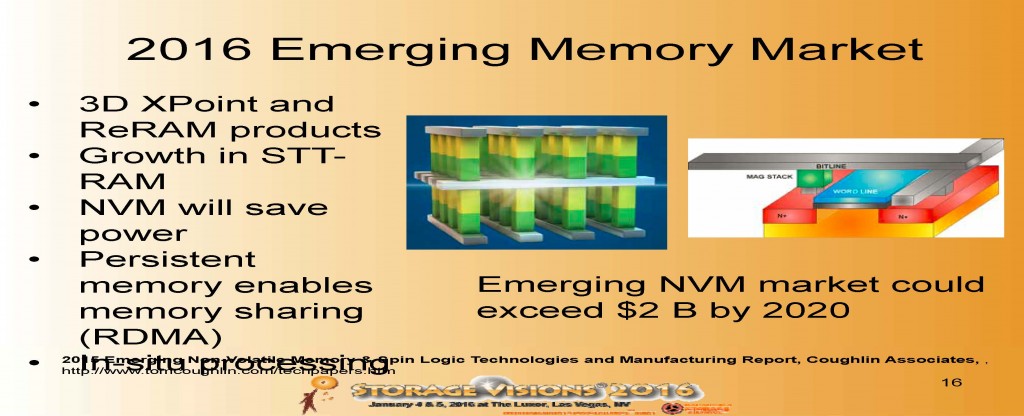
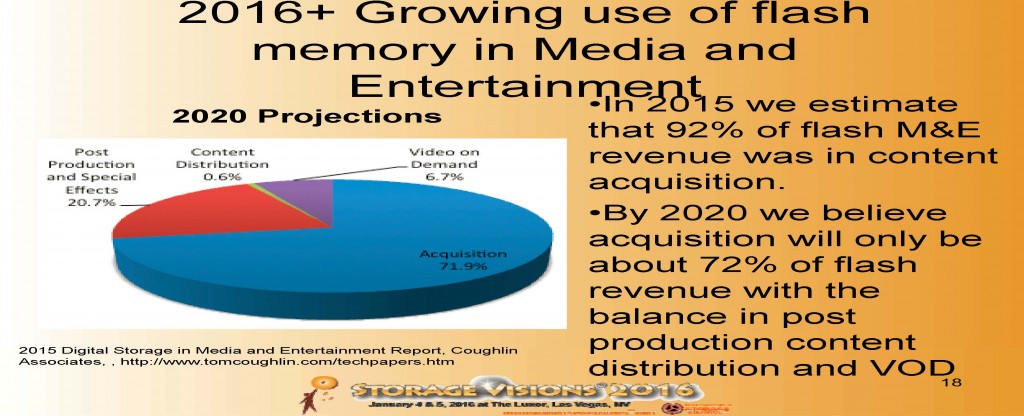
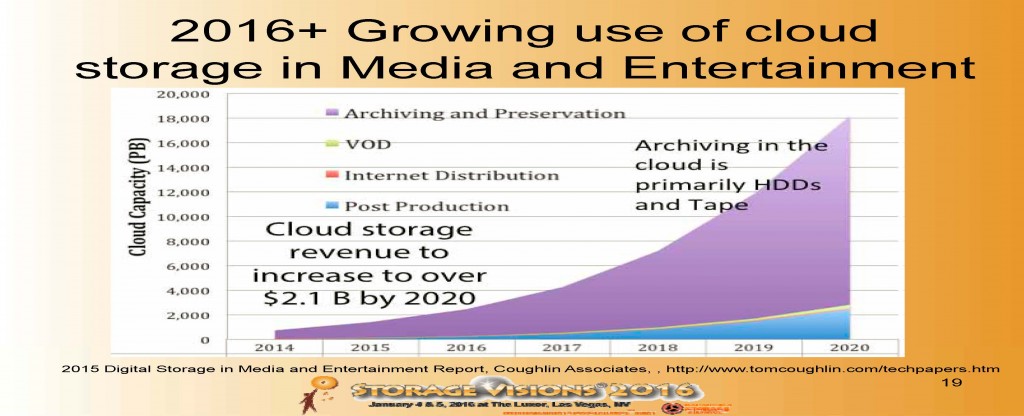
As the summary for years ahead we will see: continued consolidation in the storage industry, storage capacity growth with IoT, Big Data and more, mobile consumers get more storage as flash price goes down, demand goes up, greater movement of content to the cloud, more software defined storage services, HDD shift to capacity continues (12TB in 2016?), shift to 3D flash with majority of production by 2018.
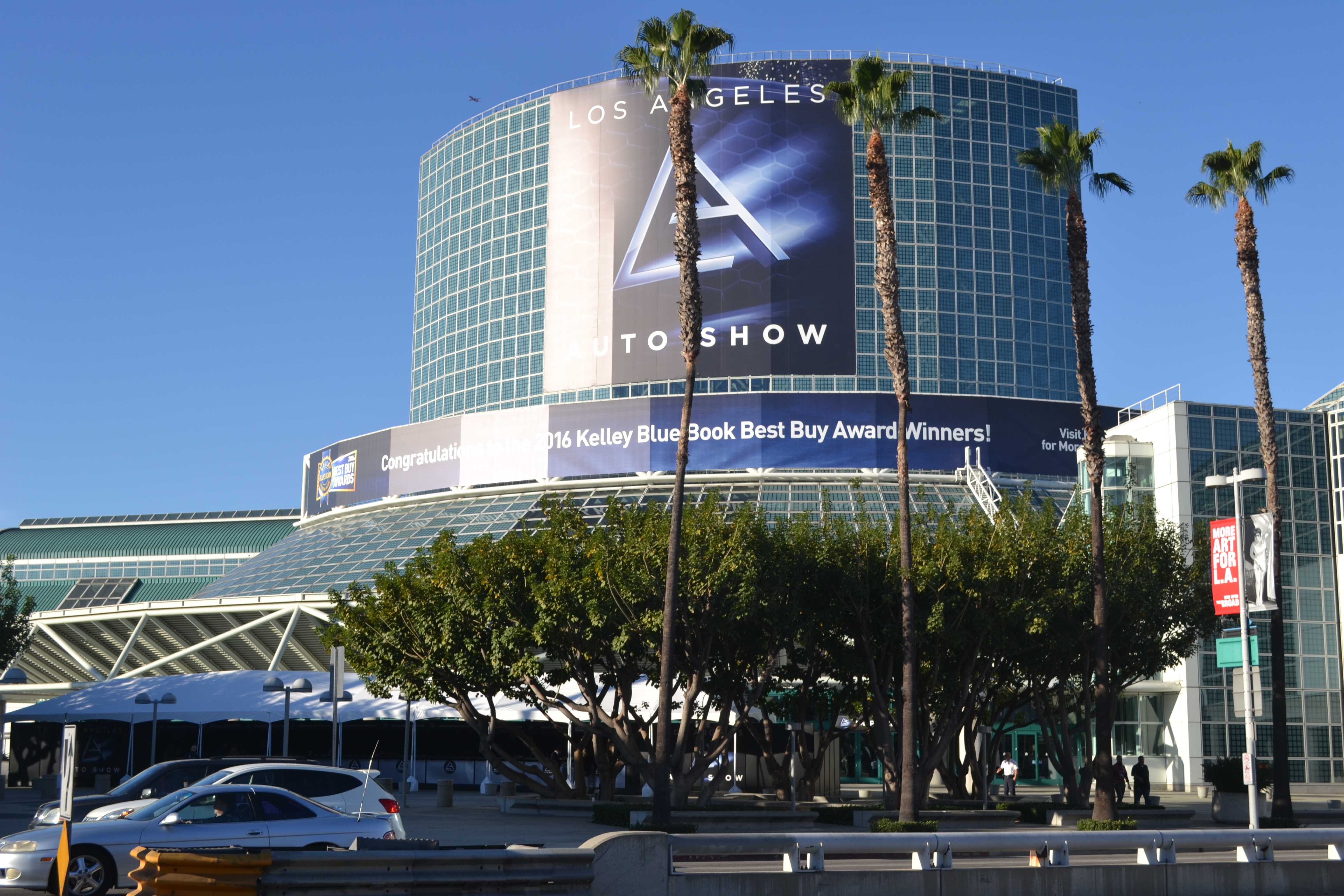
by Lidia Paulinska | Dec 16, 2015
The Connected Car Expo took place in November 17-19 at Marriott Hotel in the downtown Los Angeles. The Press and Trade event that unites automotive and technology professionals in the connected car industry this year again gathered the major top players and media.
In his openings remarks the mayor of Los Angeles Eric Garcetti stated that people are waiting for time that technology liberate them from daily traffic daily and increase the safety they seek on the streets. And, it is the right moment when the technology is embracing the future instead of chasing it away.
Michelle Avary, VP Automotive Product & Strategy at Aeris and CCE Advisory Board member presented Top Ten Automotive Startups. Michelle is also a Founder of Women in Automotive Technology startup, Silicon Valley based networking group. She shared the outline of the selection criteria that CCE Advisory Board use to choose the notable startups in connected cars field. That are four broad categories: safety, mobility, connectivity and autonomous. The Winners of 2015 Top Ten Startups of the New Automotive Industry are: Capio, High Mobility, TriLumina, Getaround, Elio Motors, Sober Steering, Driversiti, Quanergy, Nebula Systems and HopSkipDrive.
Then CCE Emcee Brian Colley, Editor-at-large and host of CNET On Cars, took the stage to address the status of connected cars industry. What is the future of our streets and our cities? It can be called the connected cars era.
For the first time in 2015 an autonomous car drove across U.S. coast-to-coast road trip. On the panel The Long and Winding Road to Autonomous three experts: Prof. Dr. Thomas Form, Head of Electronics and Vehicle Research at Volkswagen, Brian Droessler, VP of Software & Connected Solution at Continental North America and Ph.D. Gary O’Brian, Global Director of Advanced Engineering at Delphi Electronics and safety discussed what the industry has done and what still need to be done in the road to highly automated driving.
What is the future of our streets and our cities?
As we have seen the last few years, it is conversion to digital and electronics devices that have been flowing into the cars. In the next 10 years we will be seeing a change in the information, entertainment, navigation and logistics in our vehicles. There are changes on how we relate to the cars, how we fit with them and what we expect from them. The connected cars are taking their seat at the table in electronic digital connected world and are a part of the Internet of Things (IoT).
When we think about technology, the mental picture that comes to our mind is: smartphones, smartwatches, and tablets. It should be so, because we have many types of devices in our lives. The reality is, the electronics and electronics devices are not technology. Technology is a word that we can find in dictionary, a word that pre-dates the era of electronics and pre-dates of the era of electricity. Technology by a definition is: “A branch of knowledge that deals with the creation and use of technical means and their interrelation with life, society, and the environment”. Technology in simply words means how we get things done. In the vehicles it means how we get where we want to go; how we do it efficiently, comfortably, and safely with the vehicle serving us, as oppose to us have to alter our life around the need of transportation.
There are 4 great challenges and requirements that we need to overcome and meet for connected cars:
Transparent – limit distraction via using the clean interface on the dashboard. In the past we had the remote controls that were extremely complicated and the customers were lost and did not use many of the functions. Simply too much was too much. That cannot be the case for the car, the connectivity has to allow for focus on the driving, not the interface.
Intuitive – Easy to understand how to use and why, because the connected cars speak to the entire population: people in different professions, tech geeks, TV enthusiasts, etc. Why means they need to understand– what is a benefit for a customer to have connected car, autonomous car, why they need that future.
Intimate – the internet is the future of the car. When we look at the cars now, the relationship between us and car is dumb in many aspects. The car doesn’t worry about you, the car doesn’t care about you, it doesn’t know more about you from the day bought and brought it home to the day you sell it. It is itself. The car is just kind of a cold machine for the most part. In the future, the personalization will be flowing into the car through the connectivity, and make it better today than was yesterday. More about me the driver, better tuned to what I need from it. This experience as well as services that we bring in, as the driver, I need them to follow me into the car, not just have them live on my phone, my desktop, my tablet, my TV or my home.
Constant – Reflecting the kinds of services that are second nature outside the car. At present, the car is an island. You have a routine of behaviors in your life, then, when you get into the car, the behaviors change, it is different. The view is different for the navigation dash, it use different media services. In the cars we feel a little cut off from our regular life, sort of an awkward little connection to those things we do outside of the car. This will be changed when we have constant heartbeat of all our services, relationships, personalization and digital world following us into the cars consistently. This will make the transportation aspect of our life consistent with the rest so it feels like the same space we live in, just one that is moving.
This is the goal of the connected car and what it brings, a new portion of our life that is now a continuation of the way we live, not a break from the real life or being held hostage and in limbo in traffic. Work, social interaction, entertainment, enjoyment of the trip, recognition of who you are and what you do will all be part as the new experience for getting from point A to point B in a car in the next few years.
Text by Lidia Paulinska and Tomasz Kolodziejak

by Lidia Paulinska | Nov 28, 2015
The two-day KTech – KGlobal@Silicon Valley 2015 symposium and expo organized by the Korean Ministry of Science, ICT & Future Planning along with KOTRA Silicon Valley; was dedicated to promote Korean technology and its ties with Silicon Valley. The event took place on November 12-13, 2015 at Marriott hotel in Santa Clara, CA. The opening remarks were delivered by Yong Soo Kim, Assistant Minister of Science, ICT and Future Planning, ChangYup Na, Managing Director of KOTRA in Sillicon Valley, Jong-Lok Yoon, President of National IT Industry Promotion Agency, Congressman Mike Honda from 17th District of California and Dongman Han and Consul General of Republic of Korea in San Francisco.
The main theme of this year event was “Automated Future: Human + Technology”.
The first keynote speaker Curtis Sasaki, Vice President of Ecosystems and IoT General Manager from Samsung Electronics stated that in 2020 many of our devices will be connected. Sasaki who worked in the past at Apple and Sun Microsystems, and today at Samsung, the most recognizable brand from Korea, described some effort and the products that company offers: Samsung Sleepsense, the sleep monitor, Samsung Gear S2, stylish and smart watch, and Samsung gear VR. According Sasaki, next area where we should expect a lot of traffic is VR (Virtual Reality). And VR is not just for a gaming but may also conquer other territories such as real estate, where surprisingly, people are willing to buy a house without visiting it or in education where the technology can offer the VR tour of the world in every school. Samsung applied the VR in their smartphones, like the Galaxy 5, and just headphones are needed to get a VR experience. In his summary, Sasaki pointed out the challenges that society faces nowadays and summarized the solutions: IoT can be a catalyst, partnerships are critical, technology and innovation are moving at an even faster pace than in the past.
A world experienced wide robotics revolution – stated second keynote speaker Rodney Brooks, Founder, Chairman and CTO of Rethink Robotics – sustaining growth in the face of demographic inversion. Brooks is convinced that time for the robots to interact with humans in the daily life is now. As he described it: It knows what you mean and it does what you want. Radical rethinking of manufacturing strategies is underway. The time is now because of convergence of Industrial Internet (Intelligent devices networked into intelligent systems), Additive manufacturing (Changing the economics of scale), Near-shoring (Benefit of low-cost outsourcing is eroding), Digital revolution (Cheap sensing, cheap computation, pervasive connectivity). As the population enjoys long life expectancy the robotics is going to get pulled into in home for elder care and find it use in the aging population. Brooks showed the statistics from Europe, 1950 when the population reaches 349.8 million and life longevity was 80, in Europe 2050 the population will be 401 million with life longevity to the late 90. The speaker reminded the audience that the first commercial robot was developed was in a GM factory in New Jersey in 1961. Today robotics represents baxter, research robot; the product of robust and growing developer community sharing code and applications, uses the Unified RobotDesriptor Format (URDF) for collaboration across groups, uses open source ROS framework, the standard in academia and corporate research, complete robotics platform with low-level control for custom application development, interface for custom end-effector development.
The keynote speakers set the mood for a vibrant Automated Future: Human + Technology panel discussions over the next two –days of KTech symposium. Meanwhile more than 35 Korean companies in security, wearables, big data, e-learning, hardware and software were presenting their solutions for the world at the expo area along with international job fair at the Marriott hotel in Santa Clara.
Photos of the event can be found at: https://brightblueii.com/photos/ktechsilicon-valley-2015/
More information at the website: http://www.ktechsv.org/
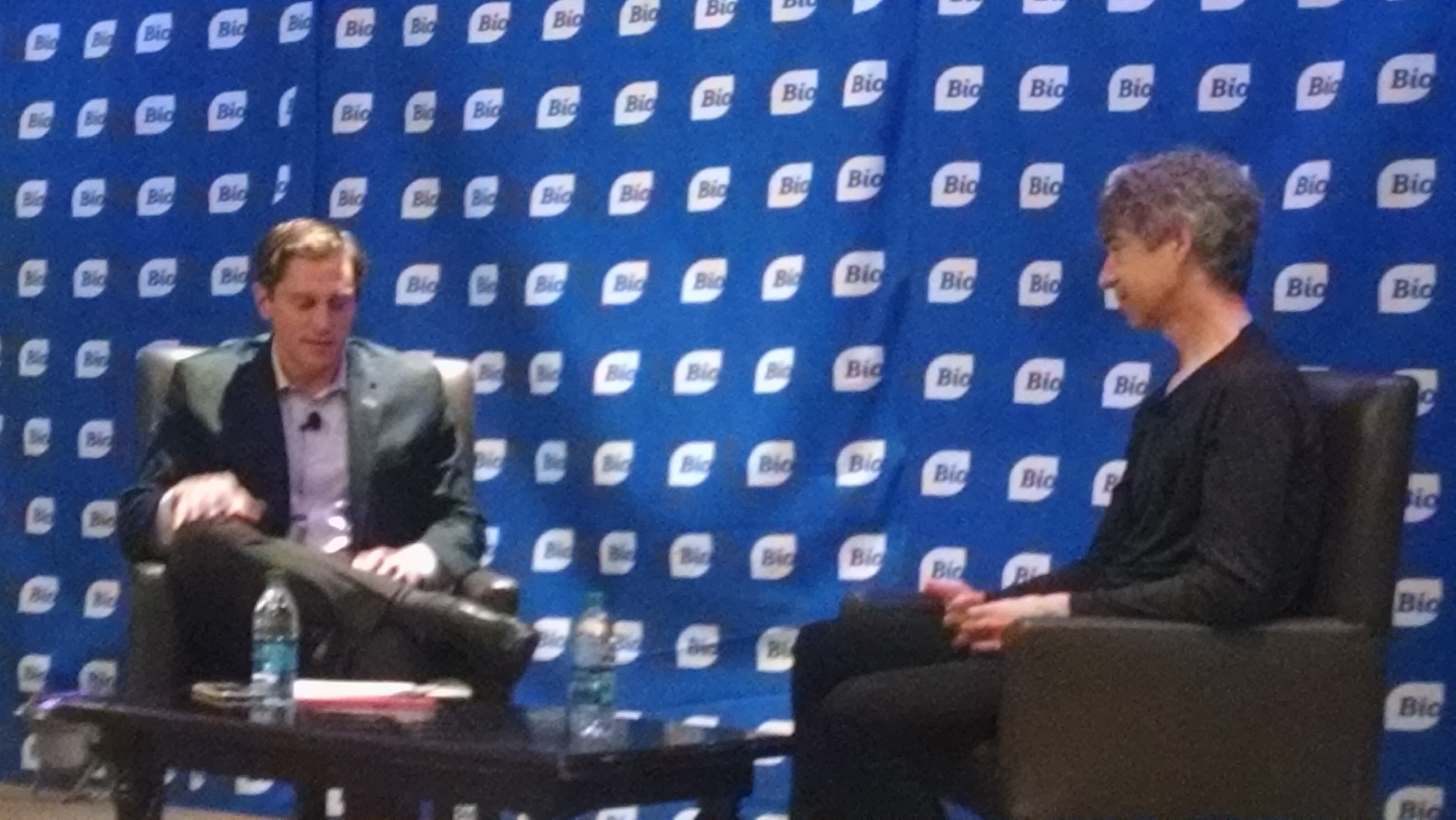
by Lidia Paulinska | Nov 25, 2015
The lunchtime plenary session at the Bio Investor Forum in San Francisco featured a fireside chat with BioTech investor Robert Nelsen. Nelsen described himself as a self-motivated investor who started his investment in projects at age 11. His key strategy today and main personal belief on investing is that science and technology matters, and that basic research is key. His premised was explained in his love the Scientific American which has a section showing the understanding and ideas in science 10, 20 and 50 years ago. The results shown in this section, are that what science understood at a given time was wrong based on the current understanding and science. This is an on-going challenge, as the improvements in science research and the interpretation of the results are constantly returning new explanations for basic science, and delivering new opportunities for business.
Using this information, Nelsen believes that companies should try new things and in new ways to learn the best ways to make something right, based on the latest information available. This mentality allows Robert to invest and focus big hard problems that multiple angles and aspects to address the problem. This gives multiple opportunities to find valid solutions over traditional methods. An area of the biggest interest is psychological drugs which address the varied space of Alzheimer’s disease and depression.
Right now, the cost of treatment and medication is 80% of the cost of a reactive care treatment plan. The cost increased as hospitalization and invasive methods are tried. He believes that many of these cases can be treated with drugs rather than invasive physical care. This would bring the treatment to an out-patient methodology, and dramatically impact the $3T in physical care billing annually.
From an investment and business strategy, the IP piece is secondary to getting the right scientists on the best practice for the program. The place for these pieces is cures require first line defensive IP, secondarily in the marketplace offensive position IP. This idea yields a belief that in the bay area, with the right strategy and the right team (good science and good people) can do anything and can beat big pharma to market and with innovative products.









